
Research into the 'M' Technique®
We have completed three randomized, controlled studies (Netherlands and USA) that are in the process of being written up for publication. For Pediatric Research in The Netherlands and USA please see below. We have published a clinical study looking at the effects of the ‘M’ Technique® on the brain compared to conventional massage using SPECT imaging (2008) Please click here.
Small Pilot studies: Beth Israel Hospice, New York, Scranton Hospice, Pennsylvania PA and a Fort Worth, Texas hospice found the hand ‘M’ Technique® reduced terminal agitation. Another study at Banner Desert Medical Centre, Mesa, Arizona found the hand ‘M’ technique® reduced anxiety and speeded delivery for women in labor. Lori Mitchell, a critical care nurse in Kalispell Hospital, Kalispell, Montana found the hand ‘M’ Technique® calmed patients in ICU prior to extubation. Other nurses found the ‘M’ Technique® enabled patients with multiple sclerosis to relax (ventilator-dependant).
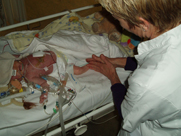 Case-studies: We have many, many case-studies and testimonials from patients, patients’ relatives and medical/nursing staff saying what an enormous difference the ‘M’ Technique® has made. Eg: sitters have found the ‘M’ Technique® enabled patients to relax prior to invasive medical procedures.
Case-studies: We have many, many case-studies and testimonials from patients, patients’ relatives and medical/nursing staff saying what an enormous difference the ‘M’ Technique® has made. Eg: sitters have found the ‘M’ Technique® enabled patients to relax prior to invasive medical procedures.
—Dr Jane Buckle PhD, MA, RN, Cert Ed
USA Research into the 'M' Technique®
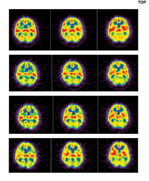 In 1996, research was carried out at Columbia Presbyterian Medical Centre, New York. The ‘M’ Technique® was applied to the legs of volunteer medical students who were connected to an 8 lead EKG monitor to measure relaxation response. The EKG showed positive response within 5 minutes.
In 1996, research was carried out at Columbia Presbyterian Medical Centre, New York. The ‘M’ Technique® was applied to the legs of volunteer medical students who were connected to an 8 lead EKG monitor to measure relaxation response. The EKG showed positive response within 5 minutes.
In 2005, a two part clinical study was carried out at University of Pennsylvania using SPECT (Single Photon Emission Computed Tomography) analysis to compare the effects of the 'M' Technique® to conventional (Swedish) massage. A radiopharmaceutical was injected intravenously into subjects before and after the intervention and 65 areas of the brain were compared. Significant differences emerged. The 'M' Technique® appeared to have a more profound effect and that effect increased when the 'M'® was repeated over time. The research was funded by the American Massage Foundation and the findings were presented at the American Massage Therapy conference in Cincinnati, OH in September 2007. The study was published in the Journal of Alternative and Complementary Medicine in October 2008. For abstract please click here. —Dr Jane Buckle PhD, MA, RN, Cert Ed
'M' Technique® Pediatric Research in USA
In 2003, a small pilot study (n=10) was carried out in the NIC unit at Texas Health Harris Methodist Hospital Fort Worth, TX. The 'M' Technique® was used on babies following circumcision. 10 randomly selected babies (34-36 gestation) who were in the NIC unit were randomly assigned to receive a) ‘M’ Technique® plus conventional treatment, or b) conventional treatment and no ‘M’ Technique®. Measuring tools were cardio-respiratory monitor, blood pressure monitor, O2 saturation, plus a neonatal infant pain scale. The intervention was carried out by an ICU RN trained in the ‘M’ Technique® and was carried out 2 hours after circumcision. The babies who received the 'M'® appeared to be in less pain than the control group and had increased O2 sats. In the ‘M’® group (n=6), 3 babies had 5% increase in O2. Two babies had 20-50% decrease in NIPS pain scale. In the control group (n=4) all babies had increased heart rate and their pain scale increased. The pilot study was followed in 2006-2008 with a randomized, controlled trial. Results replicated the original findings – reduction of pain in infants.
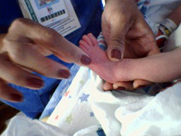
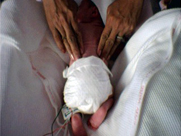
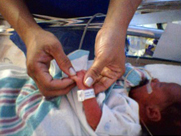
Research into the 'M' Technique® in The Netherlands
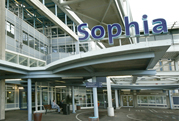
In January 2008, a single-blinded, randomized, controlled trial began in the pediatric Intensive Care Unit at Sophia Hospital, Rotterdam. The effects of the ‘M’ Technique® were compared with standard postoperative care following craniofacial surgery on 28 children. Results showed the ‘M’ Techniqu®e reduced the pain in infants. In September, a grant was received to conduct a 2nd study – this time an observational study on infants receiving Extra Corporal Membrane Oxygenation (ECMO) who were critically ill and were restricted in their movements.
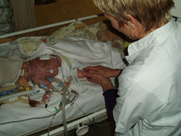
© 2024 R.J. Buckle Associates
P.O. Box 821566
North Richland Hills, TX 76182